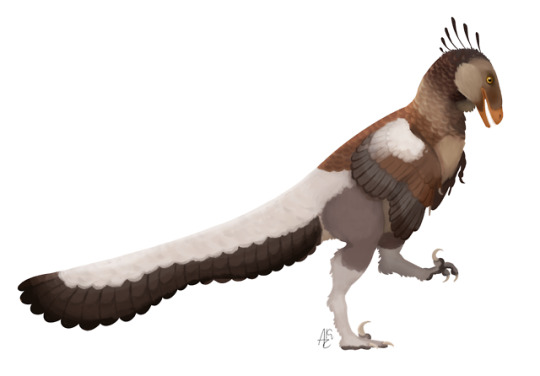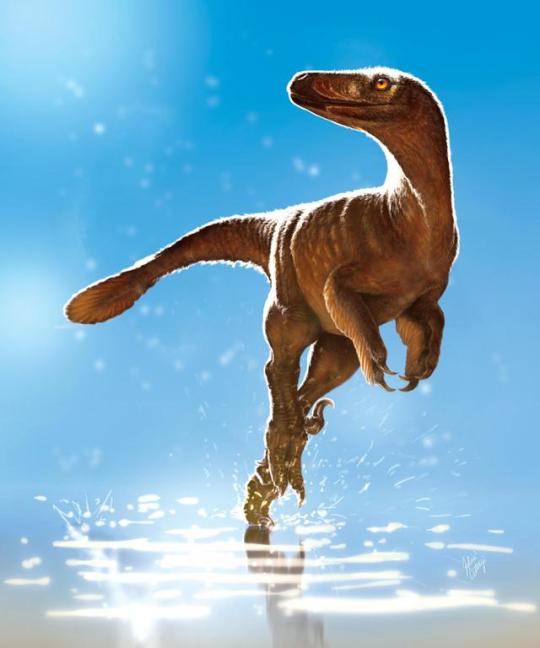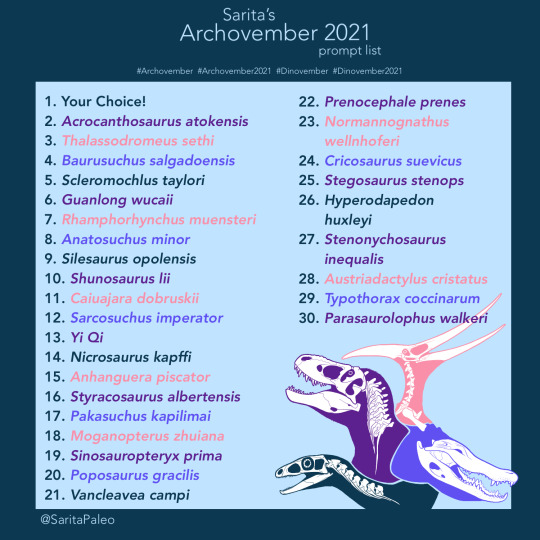#stenonychosaurus inequalis
Text

stenonychosaurus, aka troodon
#stenonychosaurus#stenonychosaurus inequalis#troodon#troodon formosus#troodontid#troodontidae#dinosaur#dinosaurs#theropod#theropoda#theropod dinosaur#feathered dinosaur#maniraptora#paleontology#paleoart#my art
912 notes
·
View notes
Text
Troodon under the blooming Magnolia tree in the Arctic summer. Many flowering plants familiar to us, including Magnolia, had evolved by Troodon's time, around 77 million years ago.
Troodon formosus
('wounding tooth, beautiful')
Troodontidae Troodontinae
A former 'wastebasket' taxon, and now possible dubious genus--though not quite dead yet. All Dinosaur Park Formation (Alberta, Canada) Troodon material currently listed as Stenonychosaurus inequalis (1932), and Latenivenatrix mcmasterae (2017). Most of the remaining material is undiagnostic (I'm not sure when this mess is supposed to be cleaned up).
Various formations, northwestern North America (Alberta, Alaska, Montana, possibly New Mexico and Texas).
Upper Cretaceous, ~77.5 - 76.5 Ma.
~
Artwork by John Conway.

Daily Dino Fact #10
4 notes
·
View notes
Text

Stenonychosaurus inequalis
#paleoart#paleontology#dinosaur#dinosaurs#theropod#stenonychosaurus#stenonychosaurus inequalis#troodon#troodontid#july 2nd 2021
303 notes
·
View notes
Text

Archovember Day 27: Stenonychosaurus inequalis
Stenonychosaurus inequalis has had quite a journey. It was named in 1932, but then in 1987 was reassigned to the genus Troodon and, for a while, it was known as /the/ Troodon: if you grew up a dinosaur fan in the 80s and 90s, this was the Troodon you grew up with (weird speculative evolution theories and all.) However, in 2017 Stenonychosaurus was restored, as the genus Troodon is considered potentially dubious (Troodon formosus is based on a single tooth; though the family are still called Troodontids.)
Stenonychosaurus inequalis was a large troodontid from Late Cretaceous Canada. It stood about 3 feet high and was around 8 feet long. It had large eyes and good vision, suggestive of a nocturnal, or at least partially nocturnal lifestyle. Stenonychus is most famous for having a very large brain in comparison to its body size. This would have made it much more intelligent than many of the other dinosaurs that shared its environment, but still about as intelligent as your average bird. (So, not as smart as a raven or parrot, but probably smarter than an owl.)
Since Stenonychosaurus had a sickle claw on each foot like dromeosaurs and some early avialans, it is assumed that they were predators. However, their teeth are different from most other carnivorous theropods, and the shape of their jaws, grasping hands, large brain, and stereoscopic vision seem to indicate an omnivorous diet, similar to a raccoon.
Stenonychosaurus lived alongside the hadrosaurs like Lambeosaurus, Corythosaurus, and Prosaurolophus, ceratopsians like Styracosaurus, Centrosaurus, and Chasmosaurus, ankylosaurs like Scolosaurus, Euoplocephalus, and Edmontonia, and pachycephalosaurs like Stegoceras and Foraminacephale. It would have been hunted by apex tyrannosaurs Daspletosaurus and Gorgosaurus and perhaps the azhdarchid pterosaur Cryodrakon.
#my art#Stenonychosaurus inequalis#Stenonychosaurus#Troodontids#theropods#saurischians#dinosaurs#archosaurs#archosauromorphs#Archovember#Archovember 2021#Draw Dinovember#Draw Dinovember 2021#Dinovember#Dinovember 2021#SaritaDrawsPalaeo
34 notes
·
View notes
Photo

A pair of Stenonychosaurus inequalis playing in the snow by Midiaou Diallo.
#Stenonychosaurus#Stenonychosaurus inequalis#Theropod#Dinosaur#Cretaceous#Mesozoic#Prehistoric#Extinct#Art
134 notes
·
View notes
Photo

Dinosaurs.
198 notes
·
View notes
Photo

Stenonychosaurus inequalis
I finished this girl a few months ago but I’ve been sitting on posting it for whatever reason
325 notes
·
View notes
Photo

Dinovember2018
6. Draw a dinosaur defending its nest
Stenonychosaurus inequalis
143 notes
·
View notes
Text
dinos. My favorites.
family: Troodontidae
subfamily: troodintinae
Genus and Species:
Stenonychosaurus inequalis
and
Latenivenatrix mcmasterae
1 note
·
View note
Note
What is your favorite species of troodontid?
Stenonychosaurus inequalis, not necessarily because it’s particularly remarkable as a species but because it used to be a favourite dinosaur of mine as a kid (mostly because I was proud that I was able to pronounce the name). I later found out that it wasn’t considered a valid genus, but recently it’s been restored to valid status as Troodon, the genus it was reassigned to, isn’t based on good enough material for anything to be lumped into it. So now the genus Stenonychosaurus is back, which I’m happy about. It’s my personal equivalent of the way people who grew up with Brontosaurus probably felt about it being reclassified as its own genus. From a science communication standpoint, Stenonychosaurus can also be used as a good example for explaining how nomenclature and naming priority works.
14 notes
·
View notes
Photo



Latenivenatrix mcmasterae and Stenonychosaurus inequalis, the former body of now dubious Troodon.
11 notes
·
View notes
Note
Heyo! I saw a post discussing a few new articles on this forum I'm on. Apparently Troodon formosus is no longer a valid genus. We now have Latenivenatrix mcmasterae and Stenonychosaurus inequalis. Not sure how this affects your dinosaur project but I just thought I'd let you know! You can find articles about it by googling something like "Dino hip discovery).
Huh, I hadn’t heard about that. I’ll have to check that out!
(one really quick google search later)
It doesn’t really chance the dinosaur project thingy, though. The real life animals are still the same, even if they might now come with a different name. That’s more on the cladistic science than morphology. I had decided early on not to use actual scientific species names in the project thingy, since it’s told from the tiny theropod tribe’s point of view, and using big sciencey Latin words doesn’t fit in their mouth. I’ll keep an eye on it in case I want to have a small info text included about the background knowledge, but we’ll see.
9 notes
·
View notes
Photo

Dino hips discovery unravels species riddle New research from University of Alberta paleontologists shows one of North America's most broadly identified dinosaur species, Troodon formosus, is no longer a valid classification, naming two others in its stead. The discovery by graduate student Aaron van der Reest leaves North America's paleontology community in upheaval. In June 2014, van der Reest discovered an intact troodontid pelvis in Dinosaur Provincial Park, leading him to take a closer look at previously collected troodontid cranial bones from southern Alberta. "That's when everything fell together and we were able to confirm that there were in fact two different species in the Dinosaur Park Formation, instead of just one," said van der Reest. He named one of the new species Latenivenatrix mcmasterae and resurrected another, Stenonychosaurus inequalis. Setting the record straight Up until then, the vast majority of troodontid specimens found in North America had been classified as Troodon formosus. "Troodon formosus has been found from Mexico all the way to Alaska, spanning a 15 million year period--a fantastic and unlikely feat," explained van der Reest, a graduate student of renowned paleontologist Philip Currie. "The hips we found could ultimately open the door for dozens of new species to be discovered," said van der Reest. "Researchers with other specimens now have two new species for comparison, widening our ability to understand the Troodontid family tree in North America." Aside from being a new species, Latenivenatrix is in a league of its own. "This new species is the largest of the troodontids ever found anywhere in the world, standing nearly two metres at the head and close to 3.5 metres long," van der Reest said. "It's about fifty per cent larger than any other troodontids previously known, making it one of the largest deinonychosaurs (raptor like dinosaurs) we currently recognize." Personal connection For van der Reest, naming a new dinosaur species has been an especially powerful experience. He has named his discovery Latenivenatrix mcmasterae, or L. mcmasterae, in honour of his late mother, Lynne (McMaster) van der Reest, whose encouragement was essential for his pursuit of paleontology. "Having brought my first find full circle, from discovery to publishing my research three years later, has been really incredible," he explained. "I can't think of a better way to honour her memory." The paper, "Troodontids (Theropoda) from the Dinosaur Park Formation, Alberta, with a description of a unique new taxon: implications for deinonychosaur diversity in North America"is published in the Canadian Journal of Earth Sciences. IMAGE....Life reconstruction of the newly discovered Latenivenatrix mcmasterae by Julius Csotonyi.
8 notes
·
View notes
Text

another Stenonychosaurus...its been too warm to draw! it's alright outside but my room is boiling! x_x
43 notes
·
View notes
Text

Here it is! My Archovember 2021 list, since we’re already a little over a week away from November (yikes)
For for those not in the know, this is my version of Draw Dinovember that I started doing two years ago to challenge myself to draw not only dinosaurs but other Archosauriformes that I have less practice with. It usually features a somewhat even mix of dinosaurs, pterosaurs, pseudosuchians, and a handful of oddball outliers.
Anyone can feel free to join in! I will be sharing art of the featured prompt for the day in my story on Instagram, including that of anyone who joins in and uses the tags. The animal prompt for each day should be posted on or after their specific day, but can be drawn at any time. You can also join in at any time and don’t necessarily have to draw every animal. The point is to have fun and learn about some interesting prehistoric critters!
Here is the full list in case the graphic is hard to read:
1. Your Choice!
2. Acrocanthosaurus atokensis
3. Thalassodromeus sethi
4. Baurusuchus salgadoensis
5. Scleromochlus taylori
6. Guanlong wucaii
7. Rhamphorhynchus muensteri
8. Anatosuchus minor
9. Silesaurus opolensis
10. Shunosaurus lii
11. Caiuajara dobruskii
12. Sarcosuchus imperator
13. Yi Qi
14. Nicrosaurus kapffi
15. Anhanguera piscator
16. Styracosaurus albertensis
17. Pakasuchus kapilimai
18. Moganopterus zhuiana
19. Sinosauropteryx prima
20. Poposaurus gracilis
21. Vancleava campi
22. Prenocephale prenes
23. Normannognathus wellnhoferi
24. Cricosaurus suevicus
25. Stegosaurus stenops
26. Hyperodapedon huxleyi
27. Stenonychosaurus inequalis
28. Austriadactylus cristatus
29. Typothorax coccinarum
30. Parasaurolophus walkeri
(Also, for new paleoartists: as a heads up when looking for refs you will come across David Peters. It is ill-advised to use any refs from the websites “pterosaur heresies” and “reptile evolution” as all those skeletals come from him and his own personal tree of life and are usually pretty innacurate.)
#Archovember#Archovember 2021#Dinovember#Dinovember 2021#Draw Dinovember#Draw Dinovember 2021#SaritaDrawsPalaeo
13 notes
·
View notes